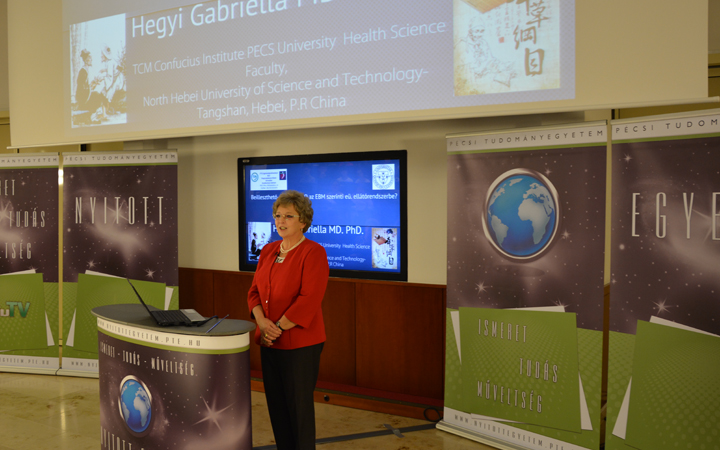Campus kredites kurzusaink célja a hallgatók megismertetése a Hagyományos Kínai Orvoslás különféle területeivel, felkelteni érdeklődésüket a komplementer medicina eme különleges része iránt.
Hagyományos Kínai Orvoslás a XXI. században I-II.
A tantárgy bemutatja a Hagyományos Kínai Orvoslás alapjait, hatásmechanizmusát, működésének modern magyarázatát, felhasználási lehetőségeit, indikációs területeit. A hallgatók megismerkedhetnek a HKO részeivel: akupunktúra, gyógynövény terápia, tuina masszázs, Qigong - mozgásterápia, dietetika, életmód tanácsadás.
Kompetenciák: A hallgatók ismeret szintjén elsajátítják a Hagyományos Kínai Orvoslásról hallott alapismereteket.
Oktatók: Dr. Hegyi Gabriella PhD., habil. kutatóprofesszor, Dr. Csütörtöki Krisztina

Integratív Medicina és a Hagyományos Kínai Orvoslás
A tantárgy bemutatja a Hagyományos Kínai Orvoslás azon alapjait, melyek az EBM tárában is elfogadhatóak és igazolhatók. modern magyarázatát, felhasználási lehetőségeit, indikációs területeit. Megismerkednek a HKO részeivel: akupunktúra, gyógynövényterápia, tuina, Qi Gong-mozgásterápia, dietetika, életmódtanácsadás. Kompetenciák: A hallgatók ismeret szintjén elsajátítják a Hagyományos Kínai Orvoslásról hallott alapismereteket.
Oktató: Dr. Hegyi Gabriella
Introduction to Chinese Herbal Medicine
Principles of Chinese Materia Medica is a fundamental subject of TCM. The theory is composed of herb and formula (prescription). Part I, Generalization and introduction, systematic structure module includes four properties, five flavours, ascending, descending, floating, and sinking, meridian tropism. Principle of prescription or formula, functions, and indications of formula, seven relations between single herbs. Part II, common herbs being applied in clinic, functions, indications, contradiction, dosage, and administration involved. Common prescriptions being applied in clinic are discussed, especially classic formula. Annotation, functions, indications, and dosage of each formula is discussed. Learning the subject is helpful for understanding TCM therapeutic idea and theory.
Introduction to Traditional Chinese Medicine
This TCM course will give a brief introduction of Basic TCM principles, mainly includes basic theory and basic diagnosis methods. The basic theories of TCM mainly include yin-yang theory, five elements theory, visceral phenomena theory, which comprehensively and systematically expounds the physiological and pathological phenomena of the human body and is used to guide clinical diagnosis and treatment activities. The basic diagnosis methods mainly discuss the special diagnosis methods of TCM and how to practice in clinic, including the four diagnostic methods of TCM, such as face diagnosis, tongue diagnosis, pulse taking diagnosis; the basic ideas and methods of syndrome differentiation.
Traditional Chinese Medicine Therapies
TCM therapy is mainly divided into two aspects, internal treatment, and external treatment. This course mainly introduces external therapy. It mainly includes acupuncture, moxibustion, cupping and massage. Dredge the Qi and blood of the meridians through benign physical stimulation to achieve the effect of balancing yin and Yang.
Acupoints and Health
Acupoints and Health course consists of two parts. What is discussed in part I includes basic conceptions of meridians and acupoints, composition of meridian system and its distribution, as well as location. The partⅡfocuses on the acupoints related to health preservation and health care in the meridian system.
Analysis of Chinese Medical Herbs
The Analysis of Chinese Herbs course introduces the basics of quality control of TCM and some of its products in China. Guided by the theory of traditional Chinese medicine, it comprehensively uses the methods and techniques of chemistry, physics, biology and pharmacy to carry out the analysis of traditional Chinese medicine.
Beauty of Chinese Herbs
Traditional Chinese medicine is mainly composed of botanical medicine (root, stem, leaf, fruit, etc.), animal medicine (viscera, skin, bone, organ, etc.) and mineral medicine. Because botanicals account for the vast majority of traditional Chinese medicines, traditional Chinese medicines are also called Chinese herbal medicines. Nature is so magical that these inconspicuous substances are organically blended together, boiled into a decoction, and drunk while hot, it can actually produce many therapeutic effects such as nourishing yin and moistening the lungs, resolving phlegm and relieving cough, dispelling heat and dehumidification, promoting body fluid and reducing fire. This cannot help but admire the wonder and beauty of traditional Chinese medicine. The Beauty of Chinese Herbs course depicts the beauty of Chinese medicine in terms of its name, its fraternity, and its tolerance, etc.
Qigong – Traditional Health Protection Exercises I-II.
A HKO részét képező mozgásterápia, mely különféle gyakorlatsorokból épül fel. A gyakorlatok végzése során a mozgás együtt jár a légzés szabályozásával és koncentrált figyelemmel. A gyakorlatokba kínai qigong mester vezeti be a hallgatókat.